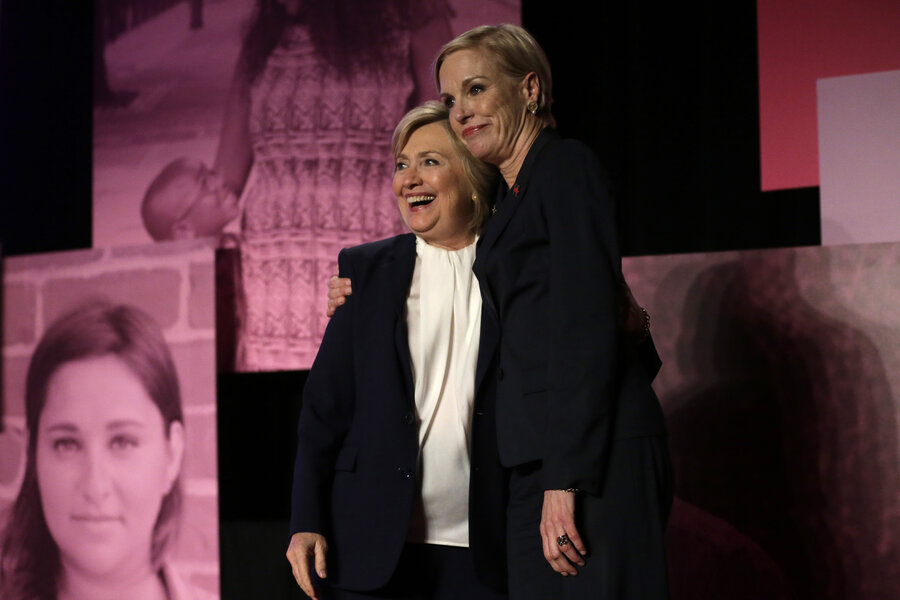Did Planned Parenthood go wrong in endorsing Hillary Clinton?
Loading...
Did Planned Parenthood endorse Hillary Clinton?
Sort of. It all hinges on a distinction between the Planned Parenthood Federation of America, the 501(c)(3) service organization that provides reproductive health services and the Planned Parenthood Action Fund, the 501(c)(4) advocacy organization that serves as the group's political arm.
The endorsement was made via the advocacy arm, the Planned Parenthood Action Fund (PPAF), which launched a new website in November, in the wake of campaigns to defund the parent organization and in support of abortion, Planned Parenthood itself, Obamacare, sex education, health equity for the LGBT community, and birth control.
“The Planned Parenthood Action Fund is a nonpartisan, not-for-profit organization formed as the advocacy and political arm of Planned Parenthood Federation of America,” according to the PPAF website.
“The Action Fund engages in educational and electoral activity, including legislative advocacy, voter education, and grassroots organizing. The Planned Parenthood Action Fund Political Action Committee (Planned Parenthood Federal PAC) is a nonpartisan political action committee committed to supporting pro-choice, pro-family planning candidates for federal office.”
At issue is the $20 million set aside for the 2016 election cycle to be spent on presidential and Senate races in battleground states. Some Planned Parenthood supporters have taken to Twitter to express their displeasure at the group's involvement in elections:
The problem, according to Elizabeth Boris, director of the Center on Nonprofits and Philanthropy at The Urban Institute, is a misunderstanding of the differences between the group's service arm, the advocacy arm, and a third sub-group, Planned Parenthood's federal political action committee.
"The $20 million pledged to the Clinton campaign is not permitted to come out of revenues designated for services to women," says Boris in an interview with the Monitor, "but are likely coming from either or both of the similarly named Planned Parenthood Political Action Fund and from the Planned Parenthood Federal PACCommittees [PACs].”
“It gives them (opponents) the ability to shade the truth because it’s very easy to tar a 501(c)(3) service organization with the political brush,” Boris says. “I understand why Planned Parenthood decided to do it in the long run because they’re under such attack. But the way the public understands a non-profit organization makes the endorsement fraught with difficulty for the overall organization.”
Boris adds, “The problem is the umbrella name is the same, they’re linked for the same goals. The misunderstanding is that people are thinking that Planned Parenthood is giving $20 million to Hillary Clinton’s political campaign out of service revenues. That’s not correct. They think money that should be spent on women is part of this money and it’s not. It’s not permitted.”
“The misunderstandings about how these organizations are connected and how they’re separate is creating the backlash,” Boris says. “The advocacy part of the organization is not the same part that provides services.”
While Internal Revenue codes prohibit 501(c)(3) non-profit organizations from engaging in political activity, it’s commonplace for non-profits to have a companion 501(c)(4) arm that is kept separate in funding and name for the purpose of taking political action. The 501(c)(4) or "social welfare" organization is allowed to engage in political activities, as long as those activities don’t become their primary purpose.
There are also political action committees for the express purpose of using "hard" money contributions to elect or defeat candidates and 527 Groups (under section 527 of the Internal Revenue Code) which raise money for political activities such as parties, candidates, committees, or associations organized for the purpose of influencing an issue, policy, appointment, or election.
“I think the backlash and my own personal experience with this is that there’s sort of an increased need for transparency and actually articulating the differences between the different entities,” says Michael Thatcher, CEO of Charity Navigator in an interview. “Being better able to better articulate the difference between these different entities is the problem. That is a transparency issue.”
Mr. Thatcher adds, “That’s what’s interesting me more on a personal level than on a Charity Navigator level is to see how all this will play out with other entities that have similar structures because it is new. It is a new move.”
[Editor's note: The original version of this story misstated how Planned Parenthood's politcal donations would be allocated.]






